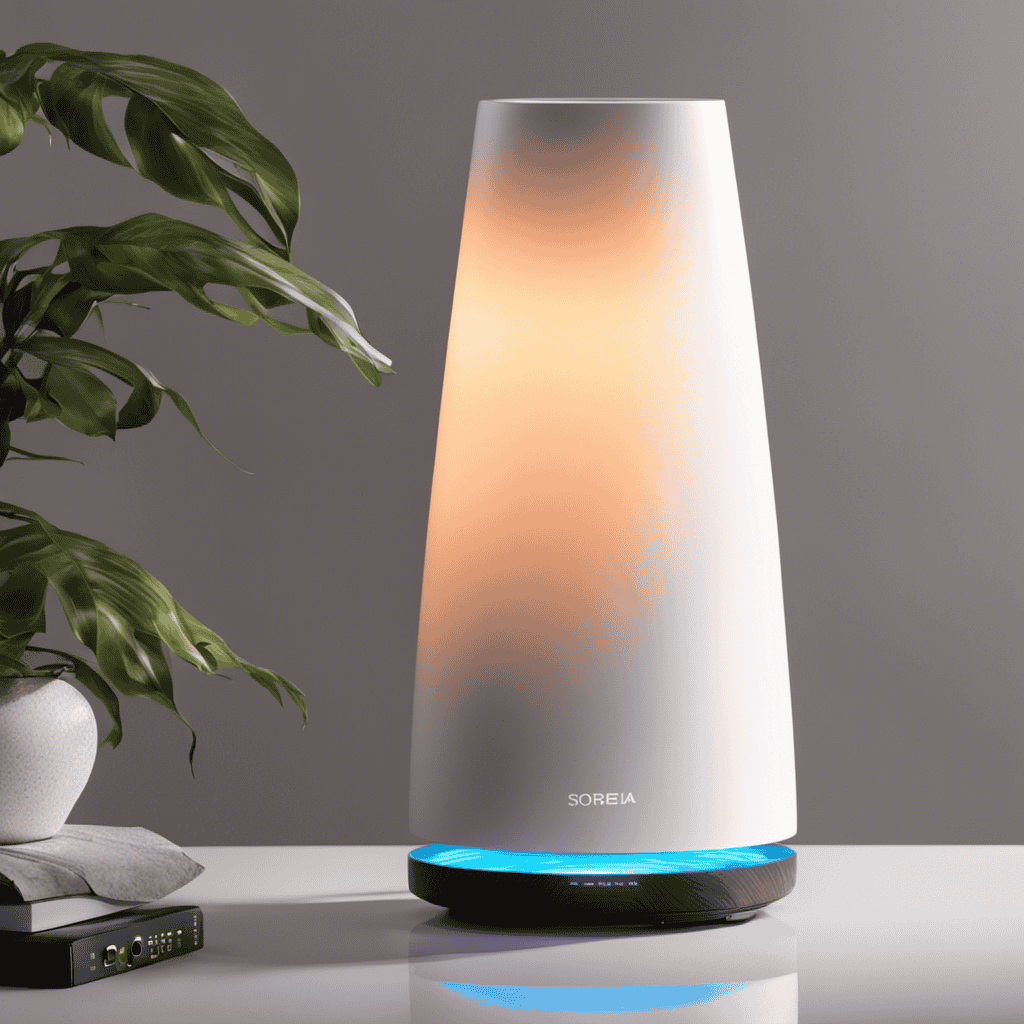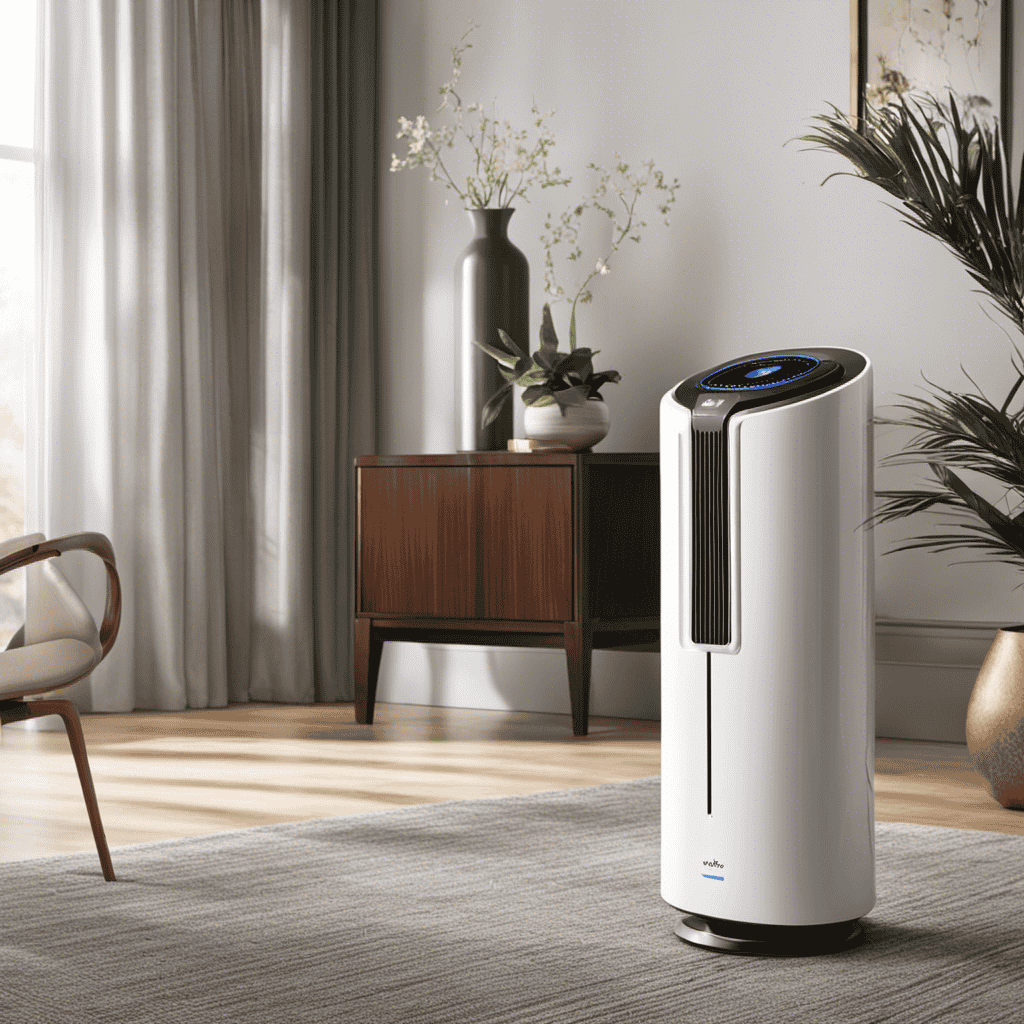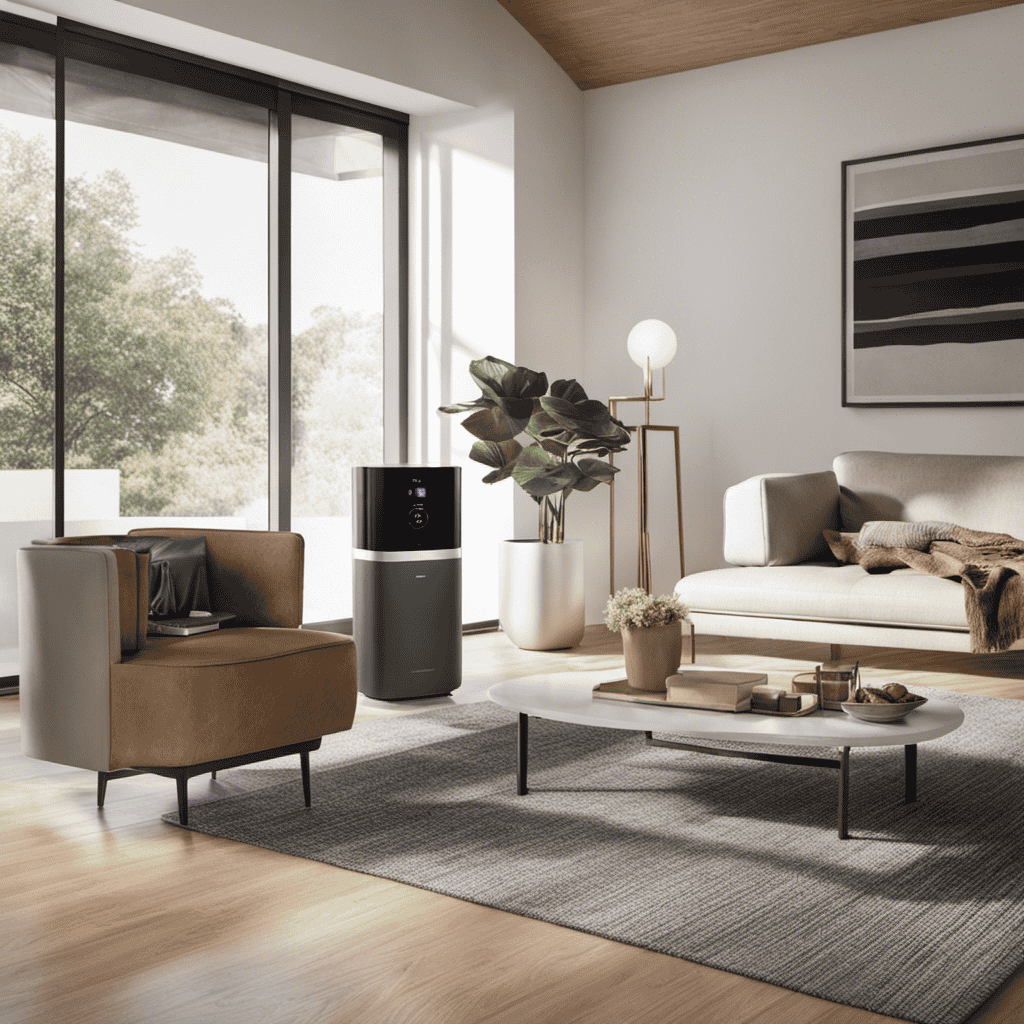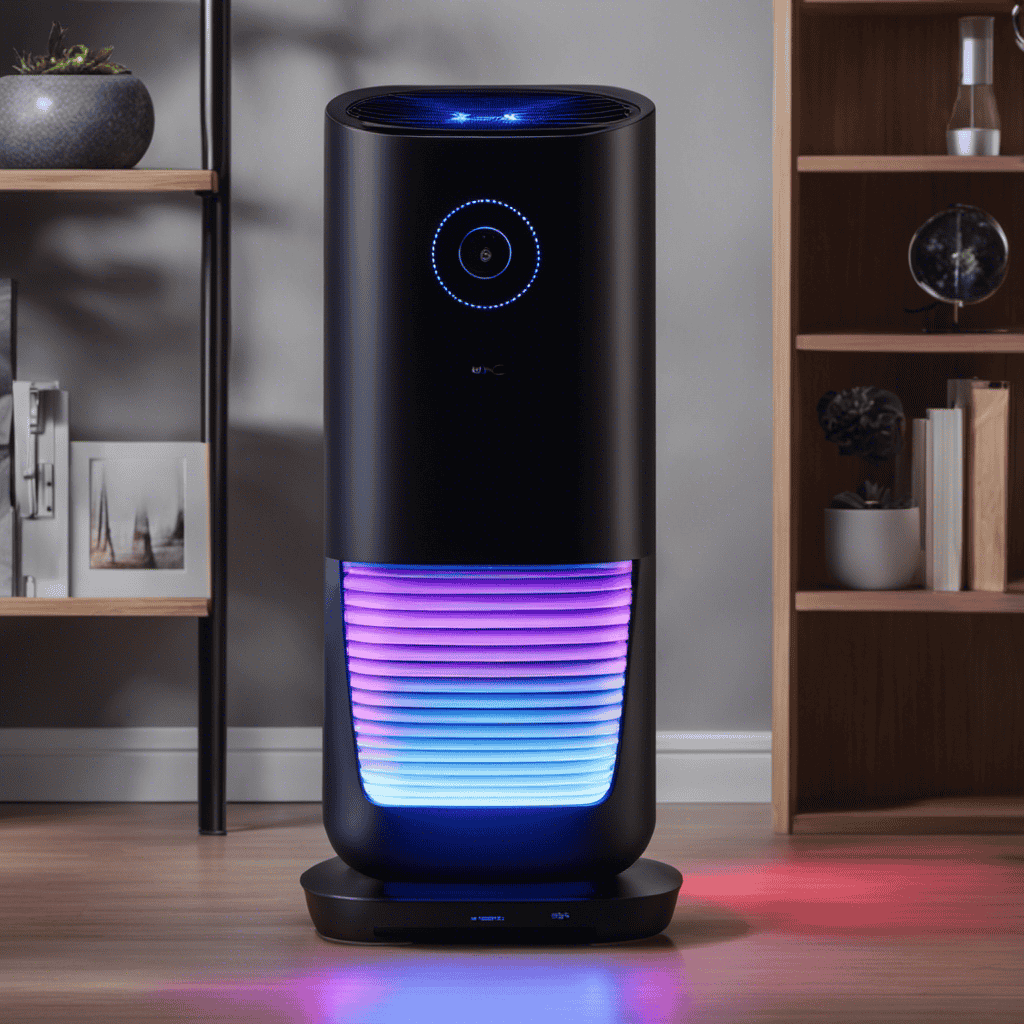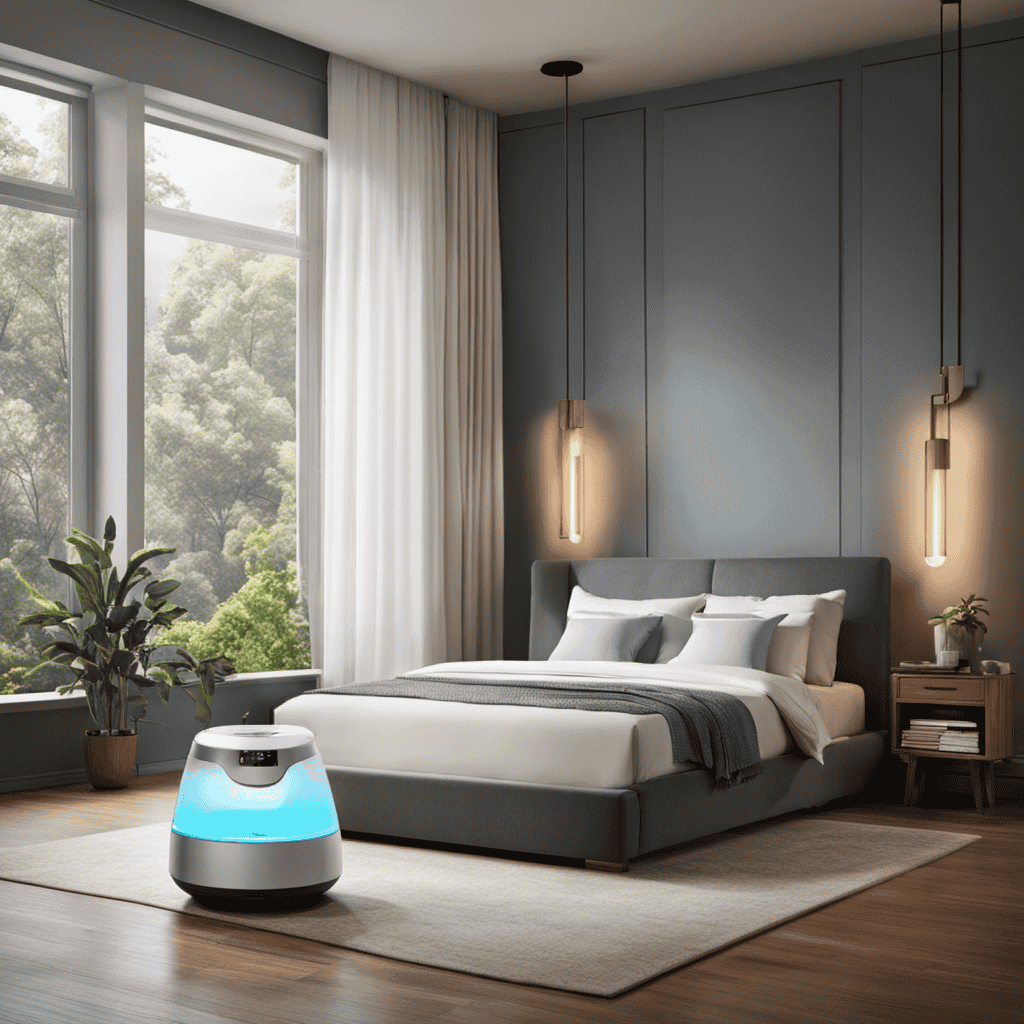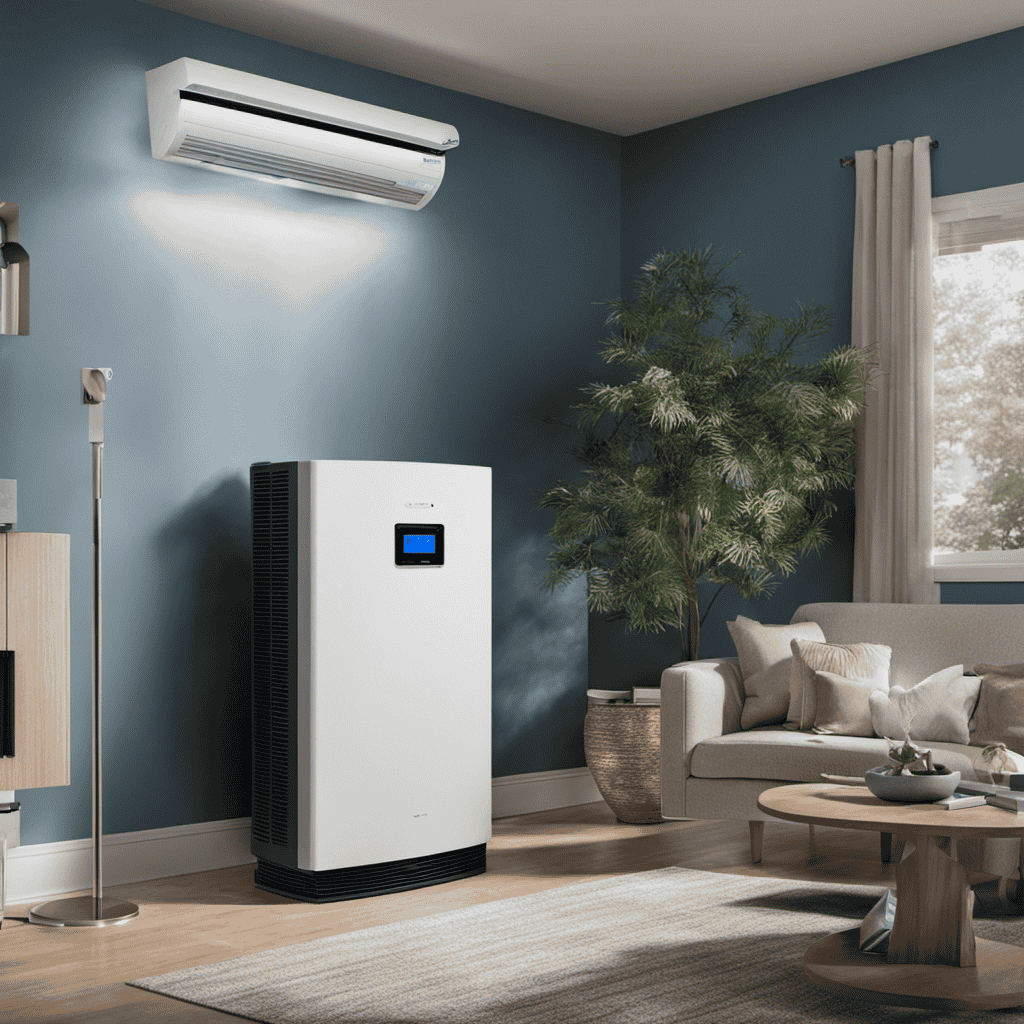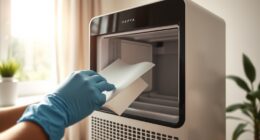As someone intrigued by the pursuit of pure, fresh air, I was drawn to explore the enigmatic function of an ionizer within an air purifier.
This ingenious technology, akin to a master conductor, orchestrates the purification process with precision.
In this article, we will unravel the secrets behind ionization and its role in eliminating pollutants from our breathing space.
Join me on this enlightening journey as we explore the science, benefits, misconceptions, and maintenance of air purifiers equipped with ionizers.
Let’s dive into the world of ionization and uncover its remarkable potential.
Key Takeaways
- Ionizers release negative ions into the air which attach to airborne particles and remove them from the air.
- Using ionizers in air purifiers improves air quality, eliminates odors, provides allergy relief, and enhances the efficiency and effectiveness of the air purification system.
- Potential health concerns and safety considerations associated with ionizers include the emission of high levels of ozone, the need for regular cleaning and maintenance, and the importance of choosing ionizers that meet safety standards and emit minimal ozone levels.
- Ionizers can be compared to HEPA filters, have the ability to remove odors, and utilize both positive and negative ions in air purifiers.
How Does an Ionizer Work in an Air Purifier
If you’re wondering how an ionizer works in an air purifier, it’s actually quite simple. An ionizer is a device that releases negative ions into the air. These negative ions attach themselves to airborne particles, such as dust, pollen, and pet dander. When this happens, the particles become charged and are attracted to positively charged surfaces, such as walls or furniture.
As a result, these particles are removed from the air, effectively reducing indoor air pollution. However, it’s important to note that there are potential health concerns associated with ionizers. Some studies suggest that high levels of negative ions can have negative effects on respiratory health, especially for individuals with asthma or allergies.
Nevertheless, when used properly and in moderation, the benefits of using an ionizer in an air purifier can outweigh the potential risks. Transitioning into the next section, let’s explore the numerous benefits of incorporating an ionizer in your air purifier.
Benefits of Using an Ionizer in an Air Purifier
One great advantage of using an ionizer in your air purifier is that it helps to remove harmful particles from your indoor environment. The ionizer technology works by releasing negatively charged ions into the air, which attach to positively charged particles like dust, pollen, and pet dander. These particles become heavier and fall to the ground or get trapped in the air purifier’s filters.
The benefits of using an ionizer in your air purifier include:
- Improved air quality: By removing harmful particles, an ionizer helps to create a cleaner and healthier indoor environment.
- Odor elimination: Ionizers can also help to eliminate unpleasant odors by neutralizing the charged particles responsible for the odor.
- Allergy relief: The removal of allergens like pollen and dust can provide relief for individuals suffering from allergies or asthma.
Incorporating an ionizer into your air purifier is a smart choice to enhance the efficiency and effectiveness of your air purification system.
Understanding Ionization Technology in Air Purifiers
As an expert in air purification technology, I would like to discuss the key points regarding ionization in air purifiers.
Firstly, let’s talk about how ionizers work. They emit negative ions into the air, which attach to positively charged particles like dust and allergens. This causes these particles to become heavy and fall out of the air.
Now, let’s move on to the benefits of ionization. One major advantage is improved air quality. By removing dust and allergens, ionizers can help create a cleaner and healthier environment. Additionally, ionization can reduce odors, making the air fresher and more pleasant to breathe. It also eliminates harmful pollutants, which is crucial for individuals with respiratory issues or allergies.
However, it’s important to address potential health concerns associated with ionizers. One concern is the production of ozone. High levels of ozone can be harmful to human health, particularly for individuals with respiratory conditions. Another concern is the release of volatile organic compounds (VOCs), which can have adverse effects on respiratory health.
How Ionizers Work
Ionizers work by releasing negatively charged ions into the air to neutralize and remove harmful particles. These ions attach themselves to airborne particles, causing them to become too heavy to remain in the air. As a result, the particles fall to the ground or get trapped in filters, improving the air quality in the room.
Benefits of using an ionizer include:
- Reduction of allergens: Ionizers can effectively remove allergens such as pollen, dust mites, and pet dander from the air, providing relief for allergy sufferers.
- Odor elimination: Ionizers can help eliminate unpleasant odors by neutralizing the particles that cause them, leaving the air fresh and clean.
- Improved respiratory health: By removing airborne particles and allergens, ionizers can help improve respiratory health, reducing symptoms like coughing, sneezing, and wheezing.
However, it is important to take safety precautions when using ionizers. These include:
- Keeping the ionizer away from flammable materials to prevent fire hazards.
- Avoiding direct exposure to the ionizer’s ozone output, as excessive ozone can be harmful to health.
- Regularly cleaning the ionizer’s plates or filters to maintain optimal performance and prevent the accumulation of particles that can reduce its effectiveness.
Benefits of Ionization
To reap the benefits of ionization, you can enjoy reduced allergens, eliminated odors, and improved respiratory health. Ionizers work by releasing negatively charged ions into the air, which attach to positively charged particles like dust, pollen, and pet dander. This process causes the particles to become heavy and fall to the ground, reducing the amount of allergens in the air. Additionally, the ions can neutralize odorous molecules, effectively eliminating unpleasant smells. The improved air quality provided by ionization can have a positive impact on respiratory health, especially for those with allergies or asthma. However, it is important to consider ionizer safety. Some ionizers produce ozone as a byproduct, which can be harmful in high concentrations. It is crucial to choose an ionizer that meets safety standards and emits minimal ozone levels.
| Ionization Benefits | Ionizer Safety |
|---|---|
| Reduced allergens | Choose ionizers that meet safety standards |
| Eliminated odors | Ensure minimal ozone levels |
| Improved respiratory health | Monitor ozone levels regularly |
Potential Health Concerns?
After discussing the benefits of ionization, it is important to consider the potential health concerns associated with using an ionizer on an air purifier. While ionizers can improve air quality, there are some factors to be aware of.
-
Ozone production: Some ionizers emit ozone as a byproduct, which can be harmful to human health when inhaled in high concentrations. Ozone can irritate the respiratory system and worsen conditions such as asthma.
-
Negative ions: While negative ions can have positive effects on mood and overall well-being, excessive exposure to them may lead to respiratory issues. Some studies suggest that high levels of negative ions can cause respiratory irritation and inflammation.
-
Maintenance: Ionizers require regular cleaning to prevent the accumulation of dust and other particles. Failure to clean the ionizer can result in reduced air quality and potential health risks.
It is crucial to consider these potential health concerns before using an air purifier with an ionizer. Regular maintenance and monitoring of ozone levels can help mitigate any negative impact on air quality and human health.
Common Misconceptions About Ionizers in Air Purifiers
One common misconception is that ionizers produce harmful ozone levels, but this is not necessarily true. While it is true that some ionizers emit ozone, the amount is typically minimal and well within safety standards. In fact, ionizers can be a valuable addition to air purifiers, as they help remove airborne particles by charging them and causing them to stick to surfaces or each other.
Another misconception is that ionizers generate harmful byproducts such as formaldehyde or other toxic gases. However, modern ionizers are designed to minimize the production of such byproducts, ensuring that the air remains clean and safe to breathe.
It is important to note that ionizers should be used in accordance with manufacturer instructions to avoid any potential dangers. Regular cleaning and maintenance can also help prevent any negative effects.
Overall, understanding the facts about ionizers can help dispel these misconceptions and make informed decisions about air purifiers and their benefits.
Factors to Consider When Choosing an Air Purifier With an Ionizer
When considering an air purifier with an ionizer, it is important to evaluate both the effectiveness and safety of this feature, as well as its impact on air quality.
Ionizers work by emitting negative ions into the air, which attach to particles and make them heavier, causing them to fall out of the air. However, it is crucial to assess the level of ozone emission from the ionizer, as high levels can be harmful to health.
Additionally, while ionizers can effectively remove certain pollutants, they may not be as effective in addressing larger particles or odors.
Ionizer Effectiveness and Safety
The ionizer on an air purifier can be effective at reducing airborne particles and improving air quality, but it is important to be aware of safety considerations. When considering the use of an ionizer, there are a few key factors to keep in mind:
-
Ozone production: Ionizers can produce ozone as a byproduct, which can be harmful when present in high concentrations. It is crucial to choose an air purifier with low ozone emissions to ensure safety.
-
Maintenance: Ionizers require regular cleaning to maintain their effectiveness. Accumulated dust and particles on the ionizer plates can hinder their performance and may even release harmful substances into the air.
-
Ionizer placement: It is essential to place the air purifier with an ionizer in a well-ventilated area. This helps to disperse any ozone produced and prevents it from accumulating in a confined space.
Understanding these safety concerns is crucial when using an air purifier with an ionizer.
Now, let’s delve into the impact of ionizers on air quality.
Impact on Air Quality
Using an ionizer can significantly improve air quality in your home or office space. Ionizers release negatively charged ions into the air, which attach to and neutralize positively charged particles like dust, pollen, and pet dander. This process effectively removes allergens and improves air quality.
Ionizers can also help eliminate odors by neutralizing the particles that cause them. However, it’s important to note that while ionizers can be beneficial for air purification, there are safety considerations to keep in mind.
Follow the manufacturer’s instructions and guidelines for safe usage, as improper use can generate harmful ozone levels. Regular maintenance and cleaning of the ionizer are necessary for optimal performance and safety.
Overall, when used correctly, ionizers provide significant benefits for improving air quality.
The Role of Negative Ions in Air Purification
Negative ions play a crucial role in purifying the air with an ionizer. These tiny, negatively charged particles are released into the air by the ionizer and work by attaching themselves to harmful particles, such as dust, allergens, and pollutants.
Here are three ways in which negative ions contribute to improving respiratory health and combating indoor air pollution:
-
Neutralizing airborne allergens: Negative ions bind to allergens like pollen, pet dander, and mold spores, causing them to become too heavy to remain airborne. This prevents them from entering our respiratory system and triggering allergies.
-
Removing airborne particles: Negative ions attract and bond with particles like dust and smoke, causing them to settle faster. This reduces the amount of pollutants we breathe in, leading to cleaner indoor air.
-
Enhancing lung function: Breathing in negative ions can improve lung function and help alleviate symptoms of respiratory conditions like asthma and bronchitis. Negative ions can reduce inflammation in the airways, making it easier to breathe.
Ionizers Vs. HEPA Filters: Which Is Better for Air Purification
When it comes to air purification, there are two main methods that are often compared: ionizers and HEPA filters. Both methods aim to improve indoor air quality, but they work in different ways.
Ionizers release negatively charged ions into the air, which attach to particles and cause them to fall to the ground.
On the other hand, HEPA filters use a physical barrier to trap particles and prevent them from circulating in the air.
Understanding the effectiveness of each method is crucial in choosing the right air purification system for your needs.
Ionizers Vs. HEPA
Ionizers are often preferred over HEPA filters for their ability to neutralize airborne particles. They work by emitting negative ions into the air, which attach to positively charged particles and cause them to fall to the ground or stick to surfaces. This can be beneficial for individuals with asthma, as ionizers can reduce the presence of allergens and irritants in the air. However, it is important to note that ionizers do not remove particles from the air like HEPA filters do. Instead, they simply make the particles too heavy to remain airborne.
Comparing ionizers and activated carbon filters:
- Ionizers: They release negative ions into the air to neutralize particles. They are effective in reducing allergens and irritants, but do not physically remove particles from the air.
- Activated Carbon Filters: They are designed to adsorb and trap odors, chemicals, and gases. They are effective in removing volatile organic compounds (VOCs) and other harmful substances from the air.
- Combination: Some air purifiers combine ionizers and activated carbon filters to provide both particle removal and odor elimination capabilities.
Air Purification Methods
Combining activated carbon filters with other purification methods can provide a more comprehensive solution for improving indoor air quality. One popular method for air purifiers is the use of ionizers. These devices release negatively charged ions into the air, which attach to positively charged particles like dust and allergens. The charged particles then become heavy and fall to the ground or stick to surfaces, effectively removing them from the air.
However, it’s important to note that ionizers can also produce ozone as a byproduct, which can be harmful to our health, especially for those with asthma. Ozone can irritate the respiratory system and trigger asthma symptoms. Therefore, it’s crucial to consider the potential risks of using ionizers, especially for individuals with asthma or other respiratory conditions.
Effectiveness of Each
To determine the effectiveness of each method, you should consider factors such as the size of the space, the specific pollutants you want to target, and any existing health conditions.
When comparing the effectiveness of ionizers, it is important to address safety concerns as well. Ionizers work by emitting negatively charged ions into the air, which attach to positively charged particles like dust and allergens, causing them to clump together and fall to the ground. However, there are some concerns regarding the safety of ionizers. Research has shown that ionizers can produce small amounts of ozone, which can be harmful to our respiratory system. Additionally, the effectiveness of ionizers in removing larger particles like pet dander and pollen is limited.
Therefore, it is crucial to carefully evaluate the effectiveness of ionizers in relation to the specific pollutants you want to target.
- Size of the space
- Specific pollutants
- Existing health conditions
Can Ionizers Remove Odors From the Air
Did you know that ionizers can effectively eliminate unpleasant odors from the air? Ionizers are a valuable component of air purifiers that can greatly improve respiratory health by removing airborne particles and pollutants.
When it comes to pet odors, ionizers can be particularly beneficial. Pets can release dander, hair, and other allergens into the air, which can lead to respiratory issues, especially for individuals with allergies or asthma.
Ionizers work by emitting negatively charged ions into the air, which attach to positively charged particles like pet odors. This process causes the particles to become heavy and fall to the ground, effectively removing them from the air.
Are Ionizers Safe to Use in Air Purifiers
When it comes to using ionizers in air purifiers, there are several important factors to consider.
One of the main concerns is the potential health risks associated with ionizers. It is crucial to examine the scientific evidence on the effectiveness of ionizers in improving air quality and compare them to HEPA filters, which are considered the gold standard in air purification.
Ionizer Health Risks
Be aware of the potential health risks associated with using an ionizer on your air purifier. While ionizers offer benefits such as improving air quality and reducing allergens, it is important to consider their safety implications. Here are some health risks to keep in mind:
-
Ozone production: Ionizers can produce ozone as a byproduct, which at high levels can be harmful to the respiratory system and exacerbate conditions like asthma.
-
Negative ions: While negative ions can have a positive effect on mood and stress reduction, excessive exposure to them can cause respiratory issues and lung irritation.
-
Maintenance: If not properly maintained, ionizers can accumulate dust, mold, and other particles, which can lead to respiratory problems if released back into the air.
To ensure your safety, it is essential to follow manufacturer guidelines, regularly clean and maintain your ionizer, and monitor ozone levels in your indoor environment.
Ionizer Effectiveness Proven
Using an ionizer on your air purifier has been proven effective in improving air quality and reducing allergens. Numerous ionizer research studies have demonstrated the benefits of using this technology.
Ionizers work by emitting negatively charged ions into the air, which attach to and neutralize positively charged particles such as dust, pollen, and pet dander. This process effectively removes these pollutants from the air, resulting in cleaner and healthier indoor environments. Additionally, ionizers have the ability to remove odors and smoke particles from the air.
However, it is important to note that there are also drawbacks to using ionizers. Some studies have shown that ionizers can produce ozone, which can be harmful to human health when present in high concentrations. It is crucial to choose an ionizer that produces minimal ozone levels to mitigate this risk.
Transitioning into the next section about ‘ionizer vs. HEPA filters,’ it is important to compare the effectiveness and advantages of these two air purifier technologies.
Ionizer Vs. HEPA Filters?
One key difference between ionizers and HEPA filters is their ability to effectively remove different types of pollutants from the air.
While HEPA filters are known for their efficiency in capturing airborne particles such as dust, pollen, and pet dander, ionizers utilize ionization technology to neutralize pollutants and improve overall air quality.
Ionizers release negatively charged ions into the air, which attach to positively charged particles like dust and allergens, causing them to become heavy and fall to the ground.
Ionizers can also help eliminate odors by neutralizing volatile organic compounds (VOCs) in the air.
Additionally, ionizers can reduce the presence of bacteria and viruses, making them beneficial for those concerned about airborne pathogens.
The advancement of ionizer technology has made it a popular choice for individuals seeking a comprehensive air purification solution.
The Effectiveness of Ionizers in Removing Airborne Particles
The effectiveness of ionizers in removing airborne particles can vary depending on the specific air purifier model. Ionizers are an important component of air purifiers that work by releasing negative ions into the air. These ions attach themselves to airborne particles, causing them to become heavier and fall to the ground or stick to surfaces, thus reducing their presence in the air.
One of the benefits of ionizers is their ability to effectively remove smaller particles such as smoke, pet dander, and pollen. However, it is important to note that ionizers may not be as effective in removing larger particles or certain types of pollutants.
Additionally, there have been safety concerns regarding the release of ozone, a byproduct of some ionizers, which can be harmful in high concentrations. Despite these concerns, when used properly, ionizers can significantly improve indoor air quality.
How Ionizers Improve Indoor Air Quality
When properly used, ionizers can noticeably enhance the quality of indoor air. Ionizers are effective in managing asthma symptoms by reducing the presence of airborne triggers such as pollen, dust mites, and pet dander. They work by releasing negatively charged ions into the air, which attach to positively charged particles, causing them to become heavy and fall out of the air. This helps to control indoor air pollution and reduce the concentration of allergens that can worsen asthma symptoms.
In addition, ionizers can remove odors and harmful volatile organic compounds (VOCs) from the air, further improving indoor air quality.
Transitioning into the next section, ionizers also have the potential to alleviate allergy symptoms.
Ionizers and Allergies: Can They Help Alleviate Symptoms
Using an ionizer can potentially alleviate allergy symptoms by reducing the concentration of allergens in the air.
An ionizer is a device that releases negative ions into the air, which attach to airborne particles such as dust, pollen, and pet dander.
These particles become heavier and fall to the ground, effectively removing them from the air we breathe.
This can be particularly beneficial for individuals with asthma or other respiratory conditions, as it helps to reduce the triggers that can worsen their symptoms.
By reducing the concentration of allergens in the air, ionizers can help improve respiratory health and provide relief from allergy symptoms.
However, it’s important to note that ionizers alone may not be enough to completely eliminate allergens, and other measures such as regular cleaning and proper ventilation should be taken to maintain a healthy indoor environment.
The Science Behind Ionization in Air Purifiers
To understand how ionization works in air purifiers, you need to know that it involves the release of negative ions into the surrounding environment. This process, known as the ionization process, occurs when air passes through an ionizer technology within the purifier. Here’s how it works:
- The ionizer technology generates high voltage, which is used to create a corona discharge.
- The corona discharge releases electrons, which attach themselves to air molecules, creating negative ions.
- These negative ions then attach to airborne particles, such as dust, pollen, and pet dander.
- The negatively charged particles become heavier and are attracted to positively charged surfaces in the air purifier, or they settle on nearby surfaces.
- This process effectively removes these particles from the air, improving the overall air quality.
Understanding the Difference Between Positive and Negative Ions in Air Purifiers
Understanding the difference between positive and negative ions in air purifiers is crucial for comprehending how this technology works.
Positive ionizers and negative ionizers are two types of ionizers commonly used in air purifiers. Positive ionizers, also known as ion generators, release positive ions into the air. These positive ions attach to airborne particles such as dust, pollen, and pet dander, making them heavier and causing them to fall to the ground.
On the other hand, negative ionizers release negative ions, which bind to positive ions in the air, causing them to settle. Negative ions can also attach to airborne particles, but instead of making them heavier, they create an electrostatic charge that causes the particles to stick to surfaces.
Both positive and negative ionizers help improve air quality by reducing the number of harmful particles present in the air.
Maintaining and Cleaning an Air Purifier With an Ionizer
Now that we understand the difference between positive and negative ions in air purifiers, let’s discuss how to maintain and clean an air purifier with an ionizer. Proper maintenance is essential to ensure optimal performance and longevity of your device.
Here are some tips to keep in mind:
-
Regular cleaning: Clean the ionizer plates or needles regularly to remove any accumulated dust or debris. This will prevent clogging and maintain the ionization process.
-
Filter replacement: Keep an eye on the filters in your air purifier and replace them as needed. Clogged filters can hinder the effectiveness of the ionizer and reduce overall air purification.
-
Troubleshooting issues: If you encounter any problems with your air purifier’s ionizer, such as a weak or malfunctioning ionization process, consult the manufacturer’s troubleshooting guide or contact customer support for assistance.
Frequently Asked Questions
Are Ionizers Safe to Use in Air Purifiers?
Yes, ionizers are safe to use in air purifiers. They help remove airborne particles by releasing negative ions. However, some potential health risks include ozone production and irritation for those with respiratory conditions.
Can Ionizers Remove Odors From the Air?
Yes, ionizers can remove odors from the air. They release negatively charged ions that attach to airborne particles, causing them to fall to the ground. This process helps eliminate unpleasant smells and improves air quality.
How Do Ionizers Improve Indoor Air Quality?
Ionizers in air purifiers improve indoor air quality by releasing negatively charged ions that attach to airborne pollutants, causing them to become heavy and fall to the ground. This process helps to remove harmful particles and improve overall air cleanliness.
Can Ionizers Help Alleviate Allergy Symptoms?
Yes, ionizers can help alleviate allergy symptoms by releasing electrically charged particles into the air, which bind to allergens and remove them from the environment. This increases the ion concentration and improves indoor air quality.
How Do You Maintain and Clean an Air Purifier With an Ionizer?
To maintain and clean an air purifier with an ionizer, follow these steps. First, turn off the purifier and unplug it. Then, remove the ionizer and clean it with a soft cloth. Finally, clean the rest of the purifier according to the manufacturer’s instructions.
What are the benefits of using an ionizer in an air purifier?
An ionizer on Coway air purifier can help to improve indoor air quality by releasing negatively charged ions that attach to and neutralize positively charged particles like dust, pollen, and pet dander. This process can reduce airborne allergens and create a cleaner and fresher environment for people with respiratory issues.
Conclusion
In conclusion, ionizers play a crucial role in air purifiers. They effectively reduce airborne pollutants and improve indoor air quality.
While some may argue that ionizers produce ozone, it is important to note that modern air purifiers with ionizers are designed to emit minimal levels of ozone. These levels are well below the safety standards set by regulatory agencies.
By understanding the science behind ionization and considering factors such as room size and maintenance, individuals can make informed decisions when choosing an air purifier with an ionizer. This will help create a healthier living environment.
